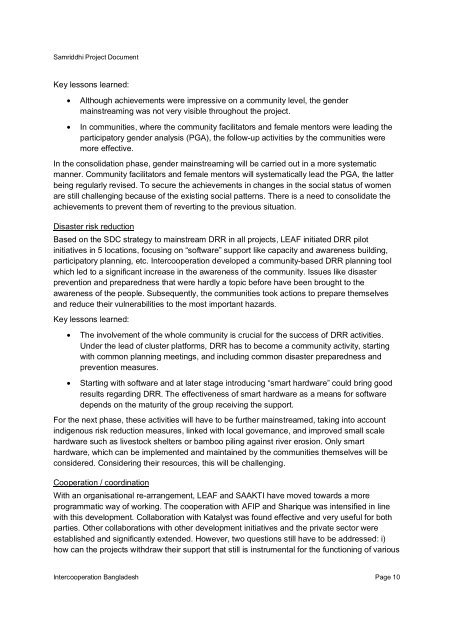Samriddhi
Samriddhi
Samriddhi
You also want an ePaper? Increase the reach of your titles
YUMPU automatically turns print PDFs into web optimized ePapers that Google loves.
<strong>Samriddhi</strong> Project Document<br />
Key lessons learned:<br />
• Although achievements were impressive on a community level, the gender<br />
mainstreaming was not very visible throughout the project.<br />
• In communities, where the community facilitators and female mentors were leading the<br />
participatory gender analysis (PGA), the follow-up activities by the communities were<br />
more effective.<br />
In the consolidation phase, gender mainstreaming will be carried out in a more systematic<br />
manner. Community facilitators and female mentors will systematically lead the PGA, the latter<br />
being regularly revised. To secure the achievements in changes in the social status of women<br />
are still challenging because of the existing social patterns. There is a need to consolidate the<br />
achievements to prevent them of reverting to the previous situation.<br />
Disaster risk reduction<br />
Based on the SDC strategy to mainstream DRR in all projects, LEAF initiated DRR pilot<br />
initiatives in 5 locations, focusing on “software” support like capacity and awareness building,<br />
participatory planning, etc. Intercooperation developed a community-based DRR planning tool<br />
which led to a significant increase in the awareness of the community. Issues like disaster<br />
prevention and preparedness that were hardly a topic before have been brought to the<br />
awareness of the people. Subsequently, the communities took actions to prepare themselves<br />
and reduce their vulnerabilities to the most important hazards.<br />
Key lessons learned:<br />
• The involvement of the whole community is crucial for the success of DRR activities.<br />
Under the lead of cluster platforms, DRR has to become a community activity, starting<br />
with common planning meetings, and including common disaster preparedness and<br />
prevention measures.<br />
• Starting with software and at later stage introducing “smart hardware” could bring good<br />
results regarding DRR. The effectiveness of smart hardware as a means for software<br />
depends on the maturity of the group receiving the support.<br />
For the next phase, these activities will have to be further mainstreamed, taking into account<br />
indigenous risk reduction measures, linked with local governance, and improved small scale<br />
hardware such as livestock shelters or bamboo piling against river erosion. Only smart<br />
hardware, which can be implemented and maintained by the communities themselves will be<br />
considered. Considering their resources, this will be challenging.<br />
Cooperation / coordination<br />
With an organisational re-arrangement, LEAF and SAAKTI have moved towards a more<br />
programmatic way of working. The cooperation with AFIP and Sharique was intensified in line<br />
with this development. Collaboration with Katalyst was found effective and very useful for both<br />
parties. Other collaborations with other development initiatives and the private sector were<br />
established and significantly extended. However, two questions still have to be addressed: i)<br />
how can the projects withdraw their support that still is instrumental for the functioning of various<br />
Intercooperation Bangladesh Page 10
















